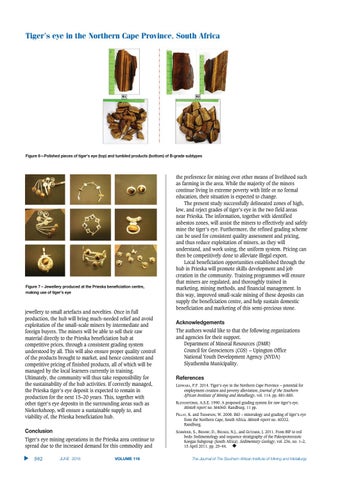Tiger’s eye in the Northern Cape Province, South Africa
%<60;>? "&:2<=4>5?3<>1>=?:-?9<6>;+=?>.>?'9:3(?875?90/,2>5?3;:5019=?',:99:/(?:-? #6;85>?=0,9.3>=
%<60;>? ? ? >*>22>;.?3;:501>5?89?94>?&;<>=$8?,>7>-<1<89<:7?1>79;>) /8$<76?0=>?:-?9<6>;+=?>.>
jewellery to small artefacts and novelties. Once in full production, the hub will bring much-needed relief and avoid exploitation of the small-scale miners by intermediate and foreign buyers. The miners will be able to sell their raw material directly to the Prieska beneficiation hub at competitive prices, through a consistent grading system understood by all. This will also ensure proper quality control of the products brought to market, and hence consistent and competitive pricing of finished products, all of which will be managed by the local learners currently in training. Ultimately, the community will thus take responsibility for the sustainability of the hub activities. If correctly managed, the Prieska tigerâ&#x20AC;&#x2122;s eye deposit is expected to remain in production for the next 15â&#x20AC;&#x201C;20 years. This, together with other tigerâ&#x20AC;&#x2122;s eye deposits in the surrounding areas such as Niekerkshoop, will ensure a sustainable supply to, and viability of, the Prieska beneficiation hub.
:7120=<:7 Tigerâ&#x20AC;&#x2122;s eye mining operations in the Prieska area continue to spread due to the increased demand for this commodity and
L
592
VOLUME 116
the preference for mining over other means of livelihood such as farming in the area. While the majority of the miners continue living in extreme poverty with little or no formal education, their situation is expected to change. The present study successfully delineated zones of high, low, and reject grades of tigerâ&#x20AC;&#x2122;s eye in the two field areas near Prieska. The information, together with identified asbestos zones, will assist the miners to effectively and safely mine the tigerâ&#x20AC;&#x2122;s eye. Furthermore, the refined grading scheme can be used for consistent quality assessment and pricing, and thus reduce exploitation of miners, as they will understand, and work using, the uniform system. Pricing can then be competitively done to alleviate illegal export. Local beneficiation opportunities established through the hub in Prieska will promote skills development and job creation in the community. Training programmes will ensure that miners are regulated, and thoroughly trained in marketing, mining methods, and financial management. In this way, improved small-scale mining of these deposits can supply the beneficiation centre, and help sustain domestic beneficiation and marketing of this semi-precious stone.
1$7:*2>56>/>79= The authors would like to that the following organizations and agencies for their support. Department of Mineral Resources (DMR) Council for Geosciences (CGS) â&#x2C6;&#x2019; Upington Office National Youth Development Agency (NYDA) Siyathemba Municipality.
@>->;>71>= LEDWABA, P.F. 2014. Tigerâ&#x20AC;&#x2122;s eye in the Northern Cape Province â&#x2C6;&#x2019; potential for employment creation and poverty alleviation. Journal of the Southern African Institute of Mining and Metallurgy, vol. 114. pp. 881-885. KLEYENSTĂ&#x153;BER, A.S.E. 1990. A proposed grading system for raw tigerâ&#x20AC;&#x2122;s eye. Mintek report no. M406D. Randburg. 11 pp. PILLAY, K. and THOMPSON, W. 2008. IM3 â&#x20AC;&#x201C; mineralogy and grading of tigerâ&#x20AC;&#x2122;s eye from the Northern Cape, South Africa. Mintek report no. 40332. Randburg. SCHRĂ&#x2013;DER, S., BEDORF, D., BEUKES, N.J., and GUTZMER, J. 2011. From BIF to red beds: Sedimentology and sequence stratigraphy of the Paleoproterozoic Koegas Subgroup (South Africa). Sedimentary Geology, vol. 236, no. 1â&#x20AC;&#x201C;2, 15 April 2011. pp. 25â&#x20AC;&#x201C;44. N
